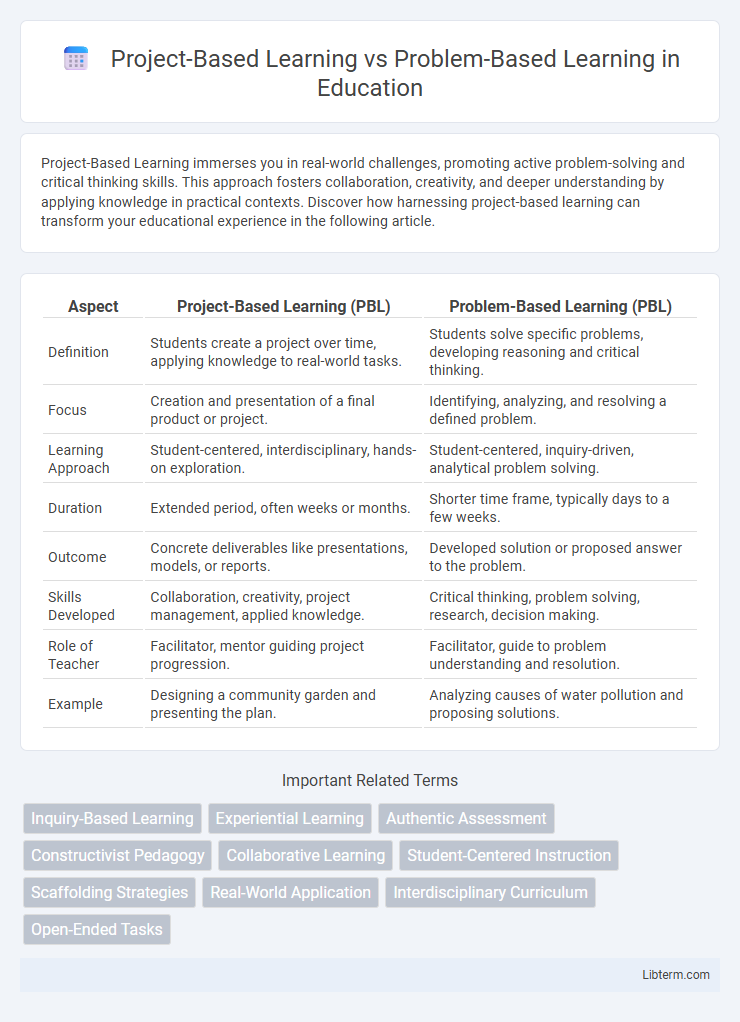Project-Based Learning immerses you in real-world challenges, promoting active problem-solving and critical thinking skills. This approach fosters collaboration, creativity, and deeper understanding by applying knowledge in practical contexts. Discover how harnessing project-based learning can transform your educational experience in the following article.
Table of Comparison
| Aspect | Project-Based Learning (PBL) | Problem-Based Learning (PBL) |
|---|---|---|
| Definition | Students create a project over time, applying knowledge to real-world tasks. | Students solve specific problems, developing reasoning and critical thinking. |
| Focus | Creation and presentation of a final product or project. | Identifying, analyzing, and resolving a defined problem. |
| Learning Approach | Student-centered, interdisciplinary, hands-on exploration. | Student-centered, inquiry-driven, analytical problem solving. |
| Duration | Extended period, often weeks or months. | Shorter time frame, typically days to a few weeks. |
| Outcome | Concrete deliverables like presentations, models, or reports. | Developed solution or proposed answer to the problem. |
| Skills Developed | Collaboration, creativity, project management, applied knowledge. | Critical thinking, problem solving, research, decision making. |
| Role of Teacher | Facilitator, mentor guiding project progression. | Facilitator, guide to problem understanding and resolution. |
| Example | Designing a community garden and presenting the plan. | Analyzing causes of water pollution and proposing solutions. |
Introduction to Project-Based Learning and Problem-Based Learning
Project-Based Learning (PBL) centers on students engaging in extended projects that integrate real-world challenges, promoting critical thinking, collaboration, and creativity. Problem-Based Learning emphasizes investigating complex problems without predetermined solutions, encouraging self-directed learning and deep analytical skills. Both methodologies enhance active learning by fostering problem-solving abilities and practical knowledge application in diverse educational settings.
Defining Project-Based Learning
Project-Based Learning (PBL) is an instructional approach that engages students in exploring real-world problems over an extended period, resulting in a tangible product or presentation. It emphasizes student-driven inquiry, collaboration, and the application of knowledge across multiple disciplines. This method fosters critical thinking, creativity, and practical skills by immersing learners in authentic projects connected to their interests and community.
Defining Problem-Based Learning
Problem-Based Learning (PBL) is an instructional method centered on students engaging with complex, real-world problems to acquire knowledge and develop critical thinking skills. Unlike traditional learning approaches, PBL promotes collaborative inquiry and self-directed learning by encouraging learners to identify what they need to know to solve the problem. This student-centered strategy emphasizes applying interdisciplinary concepts and fostering practical problem-solving abilities through active exploration.
Key Similarities Between PBL Approaches
Project-Based Learning and Problem-Based Learning both emphasize student-centered instruction that fosters critical thinking, collaboration, and real-world application. Both approaches require students to engage deeply with content through inquiry, promote active learning, and develop problem-solving skills by addressing complex, authentic challenges. The use of scaffolding, continuous assessment, and reflection are key shared strategies to support student growth and mastery in both PBL models.
Major Differences: Project-Based vs Problem-Based Learning
Project-Based Learning (PBL) centers on completing a comprehensive project that integrates multiple skills and knowledge areas, emphasizing the creation of a final product or presentation. Problem-Based Learning focuses specifically on solving a real-world problem through critical thinking and collaborative inquiry without a predefined outcome, prioritizing the learning process over the end result. Major differences include the scope and structure, where project-based approaches follow a broader, structured path leading to tangible outputs, while problem-based learning is more open-ended, fostering deeper analytical reasoning within a specific context.
Curriculum Design and Implementation
Project-Based Learning (PBL) emphasizes curriculum design centered around extended, interdisciplinary projects that foster student collaboration, critical thinking, and real-world application, often requiring clear milestones and assessment rubrics aligned with learning standards. In contrast, Problem-Based Learning focuses on curriculum scenarios posing specific open-ended problems that guide iterative inquiry and self-directed learning, promoting deeper content understanding through facilitation rather than direct instruction. Implementation of PBL typically integrates cross-curricular objectives with authentic deliverables, while Problem-Based Learning involves structured group dynamics and continuous reflection to develop problem-solving skills and metacognitive awareness.
Assessment Methods in PjBL and PbBL
Assessment methods in Project-Based Learning (PjBL) emphasize holistic evaluation, incorporating rubrics for project presentations, peer reviews, and self-assessments to gauge collaboration, creativity, and content mastery. Problem-Based Learning (PbBL) assessments focus on evaluating problem-solving processes, critical thinking, and application of knowledge, often through reflective journals, case study analyses, and formative quizzes. Both approaches utilize continuous feedback but differ as PjBL prioritizes product outcomes while PbBL centers on reasoning and solution development.
Benefits and Challenges of Each Approach
Project-Based Learning (PBL) promotes deeper knowledge retention and critical thinking by engaging students in real-world projects, fostering collaboration and creativity, but it can be time-consuming and requires significant teacher planning and resource allocation. Problem-Based Learning (PBL) enhances problem-solving skills and adaptability by focusing on complex, open-ended problems that encourage self-directed learning and analytical reasoning, though it may challenge students unfamiliar with ambiguous tasks and demand extensive facilitation from educators. Both approaches improve student engagement and practical skill development but differ in structure and implementation intensity, affecting suitability based on educational context and learning objectives.
Real-World Applications and Case Studies
Project-Based Learning (PBL) emphasizes extended real-world projects that require students to apply interdisciplinary knowledge and develop tangible products, enhancing practical skills and collaboration. Problem-Based Learning centers on analyzing complex, real-world problems through case studies, fostering critical thinking, problem-solving, and self-directed research. Both methodologies leverage authentic scenarios to bridge theoretical concepts with practical applications, promoting deeper engagement and transferable skills for diverse professional contexts.
Choosing the Right Approach for Your Educational Goals
Project-Based Learning emphasizes comprehensive exploration of real-world projects, fostering collaboration and creativity, ideal for developing long-term skills and subject mastery. Problem-Based Learning centers on solving specific, complex problems, enhancing critical thinking and diagnostic abilities, suited for sharpening analytical reasoning and practical application. Selecting the right approach depends on whether the educational goal prioritizes broad skill development through projects or targeted problem-solving expertise.
Project-Based Learning Infographic

 libterm.com
libterm.com